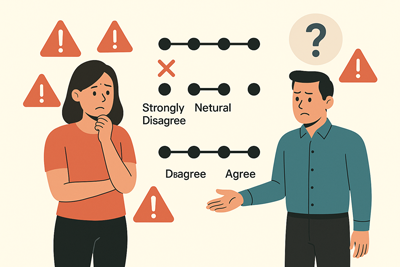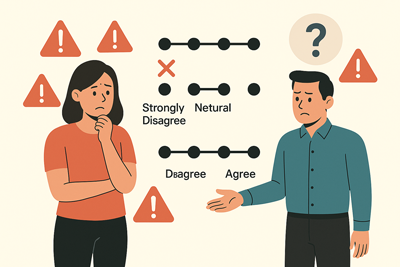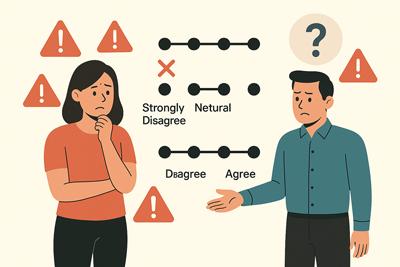How to Analyze Likert Scale Data Like a Pro
 Collecting survey responses is just the beginning of understanding your audience. The real insight emerges when you know how to analyze Likert scale data effectively — converting human opinions into actionable numbers.
Collecting survey responses is just the beginning of understanding your audience. The real insight emerges when you know how to analyze Likert scale data effectively — converting human opinions into actionable numbers.
Whether you’re conducting an employee engagement survey, a customer satisfaction study, or a brand perception assessment, Likert-based questions can tell powerful stories — but only if analyzed the right way.
In this guide, we’ll explore how to clean, code, and interpret Likert data properly, explain which metrics matter most, and show how to visualize your results like a professional researcher.
Understanding the Nature of Likert Data
A Likert scale is more than a simple questionnaire format — it’s a measurement system that translates emotions and opinions into structured, comparable values.
Responses such as Strongly Agree or Disagree are examples of ordinal data, meaning the options can be ranked in order, but the distance between them isn’t numerically equal.
For instance, moving from Strongly Disagree to Disagree might not represent the same emotional gap as moving from Neutral to Agree. Recognizing this is crucial for analyzing data correctly.
If you need a refresher on how the scale works, start with What Is a Likert Scale and How Does It Work? — a foundational explanation of the concept.
Step 1: Prepare and Clean Your Data
Before jumping into calculations, make sure your data is clean and standardized.
Export your survey results into a spreadsheet or analytics tool like Excel, Power BI, or SPSS. Check for missing, duplicated, or invalid responses.
Then, assign numerical values to your options — for example:
-
Strongly Disagree = 1
-
Disagree = 2
-
Neutral = 3
-
Agree = 4
-
Strongly Agree = 5
If you used a 7-point Likert scale, extend this pattern from 1 to 7.
Consistency is key: ensure all items follow the same direction (e.g., higher scores always represent more positive outcomes). For mixed statements (positive and negative), reverse-code where necessary to maintain alignment.
Step 2: Choose the Right Analytical Approach
Once your responses are coded, there are two main ways to analyze Likert data — descriptive and inferential analysis.
Descriptive Analysis
This approach summarizes your data using averages, percentages, and frequency distributions. It’s ideal for understanding general trends, such as overall satisfaction or agreement levels.
For example:
-
Average score of 4.5 on “I feel supported by my manager” → high satisfaction
-
70% of respondents “Agree” or “Strongly Agree” → clear positive trend
Descriptive analysis is perfect for internal reporting, employee pulse surveys, and customer satisfaction tracking.
Inferential Analysis
If you want to test hypotheses or compare groups (e.g., male vs female respondents, departments, or time periods), inferential statistics such as t-tests, ANOVA, or correlation analysis can reveal deeper patterns.
However, remember that Likert data is ordinal, so not all statistical tests apply directly. When in doubt, use non-parametric methods like Mann-Whitney U or Kruskal-Wallis tests to ensure validity.
Step 3: Analyze Frequency and Distribution
The simplest yet most insightful way to analyze Likert results is by examining frequency distributions — how often each response category was selected.
For example:
When you visualize this in a chart, patterns become even clearer. A Likert bar chart or stacked horizontal graph helps you identify trends and outliers at a glance.
Step 4: Calculate Central Tendencies
Once you’ve reviewed distribution patterns, calculate central tendency metrics such as mean, median, and mode.
-
Mean (average) provides a quick overall score but may hide polarization.
-
Median shows the midpoint of opinions, making it ideal for ordinal data.
-
Mode identifies the most frequent response, useful when you want to highlight majority sentiment.
Example:
If 65% of respondents “Agree” (score 4) and 25% “Strongly Agree” (score 5), the mean might be around 4.2, but the mode is 4 — indicating the dominant sentiment.
Be careful, though: because Likert data is ordinal, treating it purely as interval data (with equal spacing) can sometimes misrepresent real-world attitudes. The goal isn’t to force precision but to extract reliable insights that reflect genuine perceptions.
Step 5: Compare and Segment Your Data
To make your results more actionable, compare Likert responses across groups, time periods, or categories.
For instance, in an HR context, compare average engagement scores by department or manager. In customer feedback, analyze satisfaction by region or product type. This segmentation helps you uncover hidden differences and prioritize areas for improvement.
If you’re comparing results across different scale types, ensure they’re standardized — otherwise, your findings may be misleading.
Step 6: Visualize the Results
Data visualization turns abstract numbers into intuitive insights. Use charts that clearly show patterns, such as:
-
Stacked bar charts (showing distribution of responses per question)
-
Diverging bar charts (splitting positive vs negative sentiment)
-
Heatmaps (highlighting concentration of agreement or dissatisfaction)
These visuals are particularly effective for stakeholder presentations or executive summaries, as they instantly communicate strengths and weaknesses.
If you’re building reports in Excel or Google Sheets, consider using color-coded scales — green for agreement, red for disagreement — to make trends more readable.
Step 7: Interpret Findings and Draw Conclusions
Analysis is not just about numbers — it’s about meaning. After calculating averages and visualizing data, interpret your results in context.
For example:
-
An overall average of 4.3/5 indicates high satisfaction, but if one item like “Management communication is clear” scores only 3.2, it highlights a problem area.
-
If most respondents are neutral on several items, your questions might lack clarity or relevance.
Always connect your findings back to your survey objectives. The insights you extract from a Likert scale should directly inform decisions — whether improving customer service, redesigning workflows, or refining training programs.
Step 8: Combine Quantitative and Qualitative Insights
While Likert questions give you measurable data, combining them with open-ended responses can enrich your interpretation.
For instance, after a question like “I feel valued at work,” follow up with “Can you explain why you feel that way?”
This qualitative context adds depth to numerical scores and helps you understand why people responded as they did. Together, both data types create a more complete picture of your audience’s perceptions.
Common Pitfalls to Avoid
When analyzing Likert data, avoid the following errors:
-
Ignoring distribution: Relying solely on averages can mask polarization.
-
Mixing scale directions: Reversing the order of positive and negative options confuses respondents.
-
Overinterpreting decimals: A mean difference of 0.1 often isn’t statistically meaningful.
-
Forcing numerical precision: Remember, Likert data is ordinal — use ranges, not absolute values, to describe trends.
Turning Analysis Into Action
The real value of analyzing Likert data lies in what you do next. Use insights to refine your strategy, improve communication, or enhance experiences.
For example, if customer satisfaction trends upward after a new product launch, reinforce what worked. If engagement drops among specific teams, investigate their feedback in detail.
The Likert scale gives you a structured way to listen — and more importantly, to respond with purpose.
Final Thoughts
Analyzing Likert scale data is one of the most valuable skills in modern research and feedback management. It bridges the gap between raw opinions and measurable intelligence, allowing teams to make decisions backed by evidence rather than intuition.
When you apply consistent coding, proper visualization, and thoughtful interpretation, your surveys become powerful diagnostic tools. They reveal patterns that drive growth, innovation, and continuous improvement.


